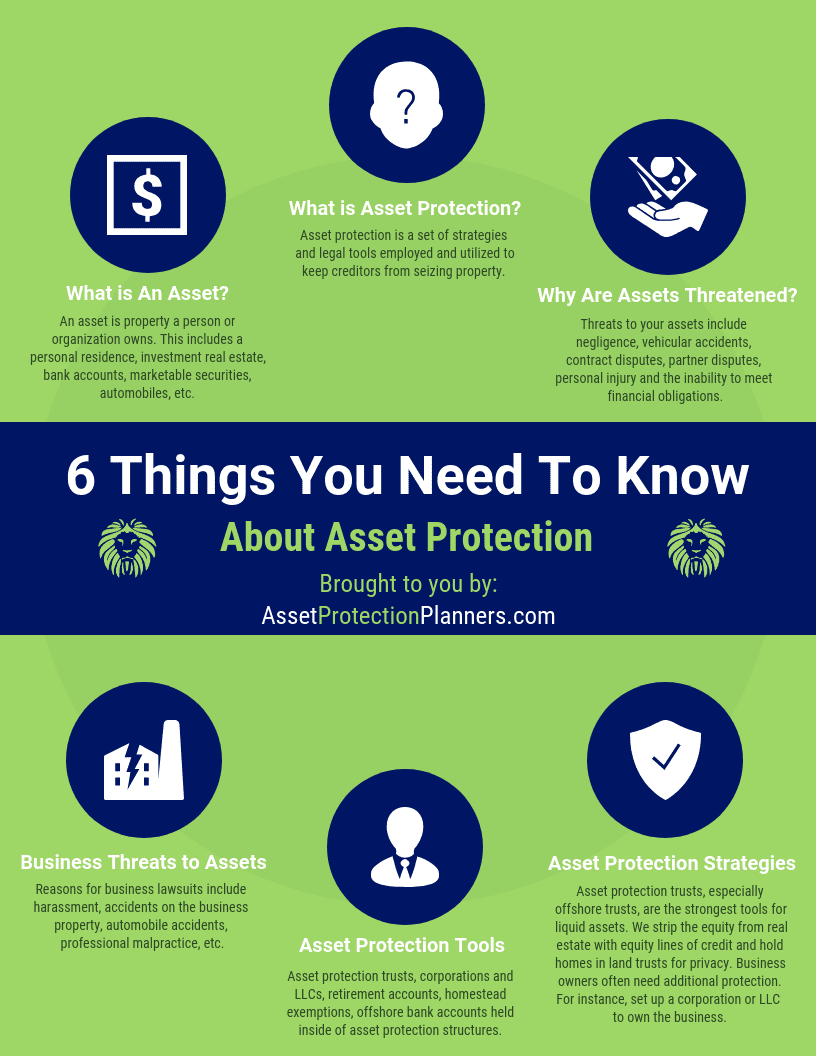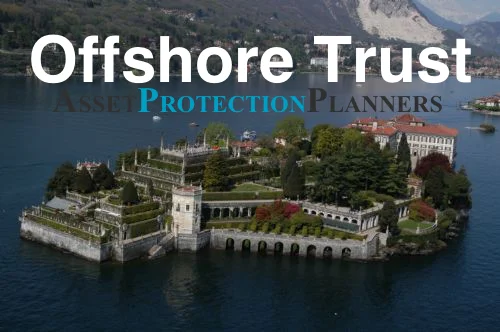
When it comes to financial success, gaining wealth is only half the battle. As a wise man once said, “Anybody can get it; the hard part is keeping it.” Asset protection planning helps you with the hard part.
If you’re already successful and want to keep your wealth intact for yourself or future generations, you’ve come to the right place. The team at Asset Protection Planners has spent decades defending people’s assets. In this article, we’ll teach you everything there is to know about asset protection planning:
- What is Asset Protection Planning?
- Who Needs an Asset Protection Plan?
- How to Make an Asset Protection Plan
- Wealth Protection: When to Act?
- Asset Protection Planning Benefits
- Types of Asset Protection Planning Tools
What is Asset Protection Planning?
Asset protection planning is the process of selecting appropriate legal tools to protect assets from creditors, divorce, lawsuits, or judgments. It involves using a tailored set of legal and lawful techniques to deter lawsuits, gain settlement negotiation power, and create estate plans. Some of the commonly used tools in asset protection plans include asset protection trusts, privacy trusts, LLCs, and equity-stripping strategies. Many plans also include offshore financial structures, as many foreign countries have more favorable trust laws than the United States.
At the core of any asset protection plan is a professional and legal examination.Creating the ideal wealth defense strategy requires an expert to assess your financial situation, assets, risks, and goals.
Who Needs an Asset Protection Plan?
Anyone with something to lose should at least consider protecting it. Most people are under the impression that asset protection planning is strictly for high-net-worth individuals. However, that’s not the case.
Here’s an example illustrating the value of an asset protection plan for those who may not consider themselves wealthy: Let’s compare how a judgment of $350,000 would impact a multi-millionaire vs. an ordinary family with a modest home, savings, and income. In the case of the millionaire, the judgment is a fraction of their total net worth. However, in the case of the family, $350,000 could represent all their net worth. If the family in this situation had an asset protection plan, they could have avoided a situation where the judgment drained all of their accounts and forced the sale of their home.
How to Make an Asset Protection Plan
Creating an effective asset protection plan is a multi-step process. To do it effectively, we recommend following these steps as a general guideline:
1. Enlist the Help of an Asset Protection Professional
The first and most important step is to consult with an experienced asset protection planner. A qualified professional can assess your situation and ensure that your plan is legally sound and customized to your specific risks.
2. Review Your Assets and Risks
Once you’ve started working with an asset protection planner, it’s time to take inventory. What assets do you have that are vulnerable? Common examples include personal savings, real estate, investments, vehicles, business interests, and intellectual property. This is also the time to consider your risk profile. Are you a landlord? A physician? A small business owner? Different professions and circumstances expose you to different liabilities. Knowing what you have and what you could lose is essential to designing an effective plan.
Learn more about Assessing Your Risk.
3. Select Your Asset Protection Tools
There is no one-size-fits-all solution for asset protection. Your advisor will help you choose from a wide range of tools, depending on your assets and risk level. Some of the most common tools include:
- LLCs and Corporations: These legal entities can protect business and personal assets by limiting liability.
- Trusts: Irrevocable trusts, domestic asset protection trusts, and offshore trusts can separate legal ownership of assets to shield them from creditors.
- Homestead Exemptions and Retirement Accounts: Many states offer legal protection for primary residences and retirement funds.
- Insurance: Umbrella policies, professional liability insurance, and malpractice coverage can provide a first line of defense against liability.
In a majority of cases, your asset protection planner will use a combination of these tools to create a defense plan that is flexible and able to readily defend against all kinds of threats, including lawsuits, divorce, and debts.
4. Establish Your Asset Protection Structure
After selecting the right tools, it’s time to put them into place. This usually involves having your asset protection planner create a legal entity and transfer property into a trust. Keep in mind that you need professional assistance for this task. Wealth defense experts have significant experience building out the components that make up asset protection plans and will ensure that your plan has all the protection needed to keep your wealth secure from creditor attacks.
5. Continually Maintain Your Asset Protection Plan
An asset protection plan is not something you “set and forget.” Laws change. Your assets grow. Your risks evolve. Annual reviews with your asset protection planner help ensure that your structures are up to date and continue to provide the level of protection you need. Simple neglect—like failing to renew an LLC or letting a trust fall out of compliance—can leave you exposed when you need protection the most.
Of these steps, the first is the most important. Provided you select a qualified wealth defense expert, like those at Asset Protection Planners, you’ll be guided down the right road.

Wealth Protection: When to Act?
Asset protection planning should take place before legal and financial threats emerge. A plan that has been in place for years stands a higher chance of holding up to legal scrutiny. After all, if you set up an asset protection plan 10 years before a lawsuit, you clearly didn’t set it up to defend against that particular lawsuit. This practice alone can prevent fraudulent conveyance charges from sticking.
Now, there are options that provide asset protection after a lawsuit is filed, but we rarely recommend them. You could rapidly set up an asset protection trust and hope that the lawsuit takes long enough for the statute of limitations on fraudulent conveyance to expire. But that requires some degree of luck, and depending on chance isn’t a plan.
Asset Protection Planning Benefits
Here is what happens when you establish a proper asset protection plan: Your legal opponent or creditor sees you as a difficult target with little to no assets within reach of a judgment. This puts you in a powerful position. The mere presence of an asset protection plan can deter a lawsuit. Even when it doesn’t, it can provide substantial negotiation leverage during settlement talks.
Other notable benefits of a well-crafted asset protection plan include:
- Financial privacy
- Lawsuit avoidance
- Judgment proofing
Financial Privacy
One of the first benefits of implementing certain legal vehicles to protect assets is building your privacy of ownership. Structures like international LLCs and land trusts allow you to hold wealth privately, which reduces your “visible” net worth. This can minimize the risk of frivolous lawsuits and predatory legal attacks.
Here’s why financial privacy is so important. When a contingent-fee lawyer reviews a case, they will perform a public records search to look for assets that can be quickly and easily liquidated to satisfy a judgment. Having no assets tied to your name drastically reduces the chances of a lawyer taking the case. Thus, it provides lawsuit deterrence.
Lawsuit Avoidance
Lawsuits and litigation are expensive drains on your finances. When you protect your assets through a well-thought-out plan, quite simply, there is less to lose. This is the equivalent of taking your chips off the table when your stakes are high.
Ultimately, preventing a lawsuit is more important than winning a lawsuit. Asset protection planning can prevent you from getting dragged into a long, drawn-out legal battle.
Judgment Proofing
When your asset protection plan includes powerful international legal tools, such as an offshore trust, it can make your assets virtually untouchable. Judges in the United States have no power over the foreign trustees who run these trusts. Even if you lose a case in the United States, your creditor will be turned away by your trustee when they show up with a U.S. court order. In short, you can lose a lawsuit and still avoid paying the judgment.

Types of Asset Protection Planning Tools
Asset protection planning can be very broad in scope. It starts small, such as carrying auto insurance. It also includes complex legal tools and business entities in both local and foreign jurisdictions. The tool you need will depend on your protection needs, lawsuit risk, and comfort level with various asset protection structures.
The primary vehicles for estate and asset protection planning are:
- Asset protection trusts
- Privacy trusts (such as land trusts and title holding trusts)
- Limited liability companies (LLCs)
- Foreign corporations and LLCs
- Equity stripping
- Homestead exemptions
Domestic Asset Protection Planning
How well do domestic asset protection tools work? Well, case law shows that there are a few good options that provide protection in the United States. The introduction of domestic asset protection trusts (DAPTs) is a relatively recent concept. Such legal entities can provide mid-level lawsuit protection for property owners, physicians, and small business owners, as well as guard against internal liability.
The problem with domestic options, as many attorneys will attest, is that some judges are insistent on getting their predetermined result. We’ve repeatedly seen judges set the law aside and seize assets from domestic asset protection trusts.
When you put assets into a trust in one state and the trust settlor lives in another, the results are bleak. The U.S. allows states to enforce their own laws across state lines. For example, if a California resident has a Nevada asset protection trust, they’re still subject to the creditor-friendly laws of their home state, rather than the trust-friendly laws of Nevada.
Offshore Asset Protection Planning

The best way to provide bulletproof protection for your assets is to remove them from your local jurisdiction. Countries like like the Cook Islands, Belize and Nevis do not recognize foreign court orders. When your assets are placed in the proper vehicles, such as an offshore trust and LLC, you get the utmost in legal protection.
These foreign jurisdictions cater to investors seeking safe harbor. Many of them offer tools to shield wealth using legal statutes that strongly favor the debtor. Foreign corporations, LLCs, trusts, banks, and investment accounts are available to diversify and secure one’s financial holdings.
Create an Effective Strategy with Help from Asset Protection Planners
Asset Protection Planners offers a personalized approach to your planning needs. Our attorneys and consultants will take you by the hand and guide you toward an asset protection plan that works for your specific situation.
While doing this, our team will inform and educate you and your personal attorneys on every available option. That way, you can make confident decisions throughout the planning process.
So, if you’re ready to start preventing lawsuits and protecting your assets, get in touch! Fill out the form at the bottom of this page to schedule your free consultation.
Learn More about Asset Protection Planning
- 5 Steps for Asset Protection from Lawsuits
- A Lawsuit Story: A Case for Asset Protection
- Asset Protection Law
- Asset Protection Planning 101
- Asset Protection Planning Strategies
- Does Asset Protection Work?
- How to Start an Asset Protection Plan
- Important Asset Protection Planning Considerations
- Legal Asset Protection Planning
- Long Term Nest Egg Protection
- The Real Truth About Asset Protection Planning
- Top 5 Asset Protection Tips
- What Is an Asset Protection Plan?
- Community Property States
- If Someone Sues You, Can They Take Your House?
- IRA Creditor Protection by State
Asset Protection FAQ
What does asset protection mean?
Asset protection means employing strategies and establishing legal tools to shield one’s assets from the claims of creditors. Both individuals and companies use asset protection to restrict creditor access to property of value within the confines of creditor-debtor law.
What are the best tools to protect assets?
The best asset protection planning tools include:
1. Land trusts for privacy of ownership.
2. LLCs for asset protection and lawsuit protection.
3. Corporations to shield personal assets from business lawsuits.
4. Equity stripping, which encumbers assets and reduces their value.
5. Offshore asset protection trusts, which are the best way to protect liquid assets

Why Is Asset Protection Important?
Asset protection is important because it reduces the risk of losing the property you have accumulated. Assets can provide financial security and peace of mind. It gives you the ability to continually provide for yourself and those you care about.


